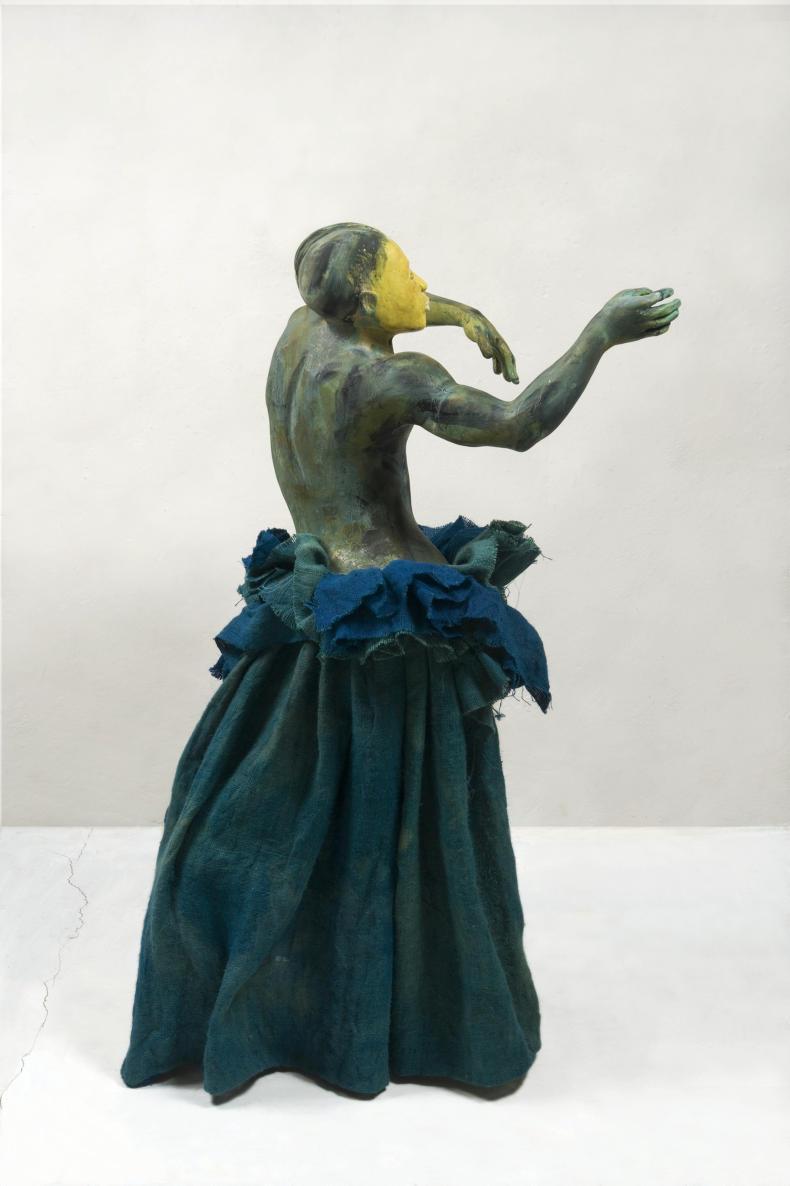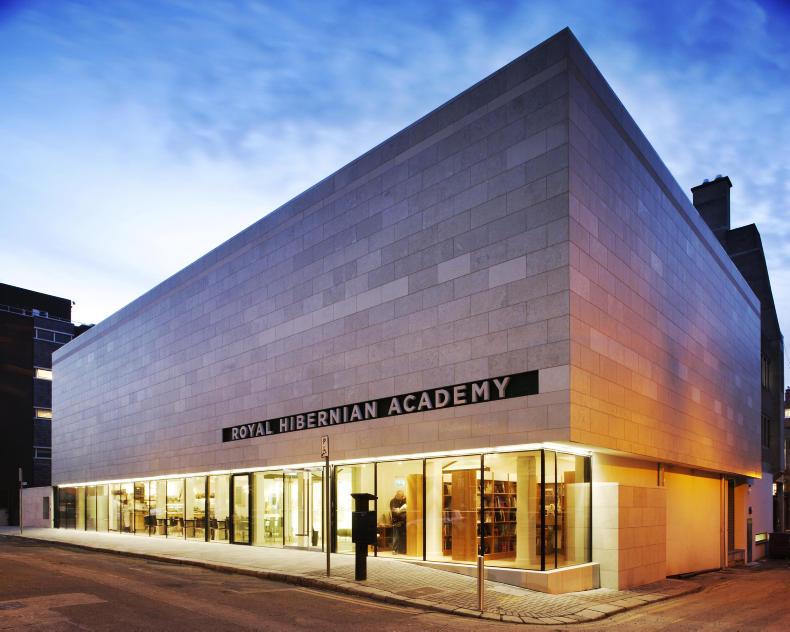Ireland’s largest and longest running exhibition of visual art, the Royal Hibernian Acadamy Annual Exhibition, is currently running in Dublin for its 189th year. It attracts over 50,000 visitors annually, showing work by more than 400 artists working in paint, sculpture, drawing, print, photography and architecture. The Academy’s president Abigail O’Brien explained the process for selection.
“Artists are invited to submit their works for the RHA Annual Exhibition through an open submission process. This process can be very daunting for some and it is taken very seriously by the selection panel.

Untitled by Janet Mullarney.
“A minimum of six Academy members work together for a week with no disruptions and everyone has their own diverse ideas and opinions. Every piece is looked at twice by the selection committee and given time.
“It is one of the last open-submission shows where, instead of looking at a digital piece, you are looking at the actual artwork. Hundreds of works are viewed every day and you can feel the excitement in the room when a gem crops up. It is intriguing to see all the various mediums, expressions, ideas, processes and trends.
“The works are viewed anonymously but, of course, sometimes an artist’s work will be recognised by someone on the panel. However, we endeavour to keep the process anonymous as this is fairer. It also means that we, the panel, don’t know if the work is by a male or female artist and it is judged purely on the quality of the work.

Portrait head of Samual Beckett by Carolyn Mulholland.
“Sometimes something quite unusual will get through and it might not be to one’s individual taste, but that is part of the experience. The selection of works is a democratic process. As a 32-county body, the RHA Annual Exhibition is also open to all parts of the country and it always brings in new talent. As the biggest open-selection exhibition in the country, it gives artists the chance to exhibit at museum standard and is a great honour for everyone who takes part.
“Personally, I have been putting work in to the Annual Exhibition since I was an art student. There were times of great disappointment when I got rejected, and times of celebration when I was accepted. This is the story of all artists and what we learn from this experience is to keep working, keep improving and developing our practice and to never give up.

Incident by Martin Gale.
“Every year we run a series of free, public talks during the exhibition. Our intention is to make the exhibition even more accessible and to reach new audiences.”
History
The Royal Hibernian Academy (RHA) originated when artists from the Society of Artists in Ireland petitioned the then-Viceroy of Ireland in the late 1700s for the opportunity to exhibit their works annually. A Royal Charter was finally granted in 1821, giving the Academy independence from all other institutions.
Today contemporary artist Abigail O’Brien is the 24th president of the RHA, the first female president in nearly 200 years. She was secretary of the RHA from 2012 until 2017, the first time a female artist had held the position. The RHA is made up of 30 members, 15 senior members and 10 associate members, all of whom are professional artists.

Friends, Liverpool Irish Centre, 2018 by Ruth McHugh.
The Academy’s first home was destroyed by fire during the 1916 Easter Rising. The keeper managed to vacate the burning building with the Royal Charter and bank records, but many works and records were lost.
The Academy was without a permanent premises until 1939, when it acquired the house and garden of 15 Ely Place, its home today.
Presently, the RHA is an artist-led organisation with charitable status. Its mission is to support contemporary art and artists in Ireland through exhibition, education and advocacy. It has a range of exhibitions, but is probably most known for the Annual Exhibition. Best of all, admission is free.
Read more
The Front Row: the NCH's new programme broken down
The Front Row: aging on the stage
Ireland’s largest and longest running exhibition of visual art, the Royal Hibernian Acadamy Annual Exhibition, is currently running in Dublin for its 189th year. It attracts over 50,000 visitors annually, showing work by more than 400 artists working in paint, sculpture, drawing, print, photography and architecture. The Academy’s president Abigail O’Brien explained the process for selection.
“Artists are invited to submit their works for the RHA Annual Exhibition through an open submission process. This process can be very daunting for some and it is taken very seriously by the selection panel.

Untitled by Janet Mullarney.
“A minimum of six Academy members work together for a week with no disruptions and everyone has their own diverse ideas and opinions. Every piece is looked at twice by the selection committee and given time.
“It is one of the last open-submission shows where, instead of looking at a digital piece, you are looking at the actual artwork. Hundreds of works are viewed every day and you can feel the excitement in the room when a gem crops up. It is intriguing to see all the various mediums, expressions, ideas, processes and trends.
“The works are viewed anonymously but, of course, sometimes an artist’s work will be recognised by someone on the panel. However, we endeavour to keep the process anonymous as this is fairer. It also means that we, the panel, don’t know if the work is by a male or female artist and it is judged purely on the quality of the work.

Portrait head of Samual Beckett by Carolyn Mulholland.
“Sometimes something quite unusual will get through and it might not be to one’s individual taste, but that is part of the experience. The selection of works is a democratic process. As a 32-county body, the RHA Annual Exhibition is also open to all parts of the country and it always brings in new talent. As the biggest open-selection exhibition in the country, it gives artists the chance to exhibit at museum standard and is a great honour for everyone who takes part.
“Personally, I have been putting work in to the Annual Exhibition since I was an art student. There were times of great disappointment when I got rejected, and times of celebration when I was accepted. This is the story of all artists and what we learn from this experience is to keep working, keep improving and developing our practice and to never give up.

Incident by Martin Gale.
“Every year we run a series of free, public talks during the exhibition. Our intention is to make the exhibition even more accessible and to reach new audiences.”
History
The Royal Hibernian Academy (RHA) originated when artists from the Society of Artists in Ireland petitioned the then-Viceroy of Ireland in the late 1700s for the opportunity to exhibit their works annually. A Royal Charter was finally granted in 1821, giving the Academy independence from all other institutions.
Today contemporary artist Abigail O’Brien is the 24th president of the RHA, the first female president in nearly 200 years. She was secretary of the RHA from 2012 until 2017, the first time a female artist had held the position. The RHA is made up of 30 members, 15 senior members and 10 associate members, all of whom are professional artists.

Friends, Liverpool Irish Centre, 2018 by Ruth McHugh.
The Academy’s first home was destroyed by fire during the 1916 Easter Rising. The keeper managed to vacate the burning building with the Royal Charter and bank records, but many works and records were lost.
The Academy was without a permanent premises until 1939, when it acquired the house and garden of 15 Ely Place, its home today.
Presently, the RHA is an artist-led organisation with charitable status. Its mission is to support contemporary art and artists in Ireland through exhibition, education and advocacy. It has a range of exhibitions, but is probably most known for the Annual Exhibition. Best of all, admission is free.
Read more
The Front Row: the NCH's new programme broken down
The Front Row: aging on the stage










 This is a subscriber-only article
This is a subscriber-only article










SHARING OPTIONS: